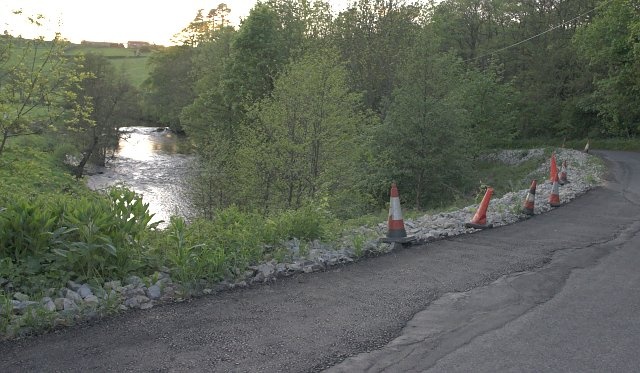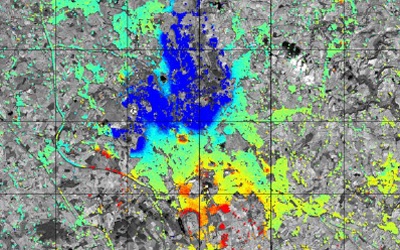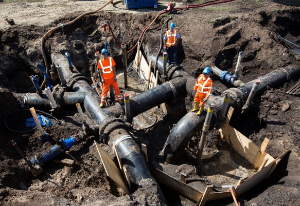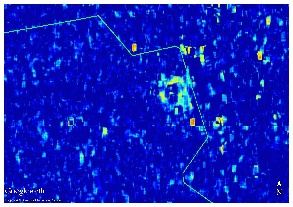Ground motion detection
Land movement is a natural phenomenon which can also be influenced by human activities. Ground motion can occur sideways or vertically and movements can be of very different size. Land subsidence refers to the downward shift of the Earth surface with respect to a baseline, such as the sea level; land heave generally takes place as a consequence to excess of water which causes the ground to expand and infrastructures to move upwards or outwards as a consequence. Soil moisture content changes have an impact on motion through clay paricles. When the soil becomes dry it also decrease in volume and the soil surface shifts down. The opposite phenomenon, also known as heave causes instead the soil to swell and slightly move upwards. Remedial activities are undertaken especially when it can result in damage to buildings and infrastructures.
These hazards can result from natural phenomena such as seismic events, volcanic deformation, landslides and ground collapse; and from more subtle processes such as subsidence, all of which have direct economic, environmental and human safety impacts. Larger magnitude ground motions are often preceded by smaller ones: it is hence important to put in place the infrastructure to detect the latter and interven to avoid or mitigate damage. The great potential of Earth observation technologies is that they allow time saving large area monitoring to assist in infrastructure design, risk management and damage mitigation. The main direct users of these type of service are urban planners, civil protection agencies, disaster management organisations and costal, rail and motorway authorities.
Satellite radar interferometry has been used for decades to measure deformation of the Earth's surface and let detect deformation that was not known beforehand. Past ground deformation can be reconstructed using time series of satellite radar measurements. The typical advantage of these data is the possibility of analysing large areas in one single spot: deformations story can be tracked using a single monitring technology. Very small movements, potentially up to 0,1mm per year can be detected, with a spatial resolution of about 20 meters, over areas up to 100km across(1). Information on vertical deformation reaches the accuracy of one millimeter and provides input to determine the degree of subsidence and the deformation rate, with a level of accuracy comparable to ground measurements. (2)
The most commonly used techniques are based on the comparison of two or more synthetic aperture radar (SAR) scenes of the same geographic area that are processed to detect ground movements. The need for more accurate and temporally dependent results has led to the inevitable technical advances seen over the last few years, including Persistent Scatterer Interferometry (PSI), used in the Terrafirma project. This techniques uses large archives of satellite radar data to identify networks of persistently scattering (i.e. radar reflecting) features such as buildings, bridges or exposed rocks. PSI software analyse the phase responses of the point targets and are able to separate the ground displacement, height and atmospheric contributions of the phase for each point.
Atmospheric contributions are estimated and removed from the results. Millimetric motion measurement are calculated retrospectively, generating both annual motion rates and multi-yeas motion histories. The levels of measurement precision achieved on the annual displacement rates are of the order +/- 0.1mm/year. The absolute spatial accuracy is about 15m, while the relative spatial accuracy is about +/- 5m in East-West and +/-2m in North-South direction. (3)
References
(1) Verbree E., Hanssen R., Swati G., GIS supported satellite radar deformation monitoring: potential and requirements
(2) Monitoring settlement using satellite data
(3) http://www.terrafirma.eu.com/index.htm
(4) Sassa K., Canuti P., Landslides. Disaster Risk Reduction.
Research paper describing the innovative technique, based on radar interferometry and implemented using ground-based instrumentation which was applied for monitoring the Tessina landslide | Radar, Interferometry | ScienceDirect | |
Research paper defining the the benefits from satellite radar interferometry in a field of mining areas protection | Interferometry, Satellite radar, land subsidence | AGH University of Technology and Science | |
Research paper describes the potential of L-band repeat-pass differential synthetic aperture radar (SAR) interferometry for land subsidence monitoring is evaluated using Japanese Earth Resources Satellite (JERS) SAR data (Requires purchasing) | SAR, Interferometry, Subsidence | IEEE | |
Research paper defining the use of InSAR technique for monitoring the spatial distribution of mining subsidence and determine quantitative | SAR, Differential interferometry, Mining, Land subsidence | Department of Fundamental Geology | |
Detection and Observation of undeground coal mining-induced Surface Deformation with differential SAR Interferometry | Research paper presents the analysis and first results of a current research and development (R&D) project set up by DSK in cooperation with the Institute for Photogrammetry and GeoInformation (IPI) | ERS, SAR, Interferometry, dInSAR, Subsidence, DEM, DTM, Monitoring, Hard Coal Mining | Institute of Photogrammetry and GeoInformation |
Research paper on a collaborative project, between Doncaster College, RJB Mining(UK), GEC Marconi Research Centre and Matra Marconi Space, to improve the accuracy of subsidence prediction models implemented in the mining industry. | Subsidence, Land Surveying, SAR, Interferometry, Mining | ESA | |
Major Urban Subsidence Mapped by Differential SAR Interferometry | Research paper on a variety of ground displacement phenomena world-wide, using proprietary CivInSAR differential interferometric processing system at NPA | Differential SAR, Interferometry, Subsidence mapping | ESA |
Space Radar Monitoring Identifies Earth Surface Subsidence Caused by Oil and Gas Field Development | Article on the importance of the exact determination of orbital parameters in interferometric processing. | Interferometry, Subsidence, Oil and gas | EURASIA |
Land Subsidence Monitoring with Differential SAR Interferometry | Research paper on potential of differential SAR interferometry for land subsidence monitoring | SAR, Interferometry, Land subsidence montitoring | ASPRS |
Deformation and seismicity in the Coso geothermal area, Inyo County, California | Research paper on observations and modeling using satellite radar interferometry | InSAR, Interferometry, Subsidence | Institute of Geophysics and Planatery physics |
Research paper reviews the technology and the signal theoretical aspects of InSAR (requires purchasing to view full text) | InSAR, Interferometry, Subsidence | IOPScience | |
Research paper discusses the evaluation procedure to assess a priori whether the techniques of contiguous and PS--InSAR are feasible for specific deformation studies in terms of precision and reliability (requires purchasing to view full text) | Satellite radar interferometry, Deformation, Accuracy | ScienceDirect | |
The contribution of radar interferometry to the assessment of landslide hazards | Research paper briefly explaining the InSAR method, with emphasis on data processing for landslide motion mapping (Requires purchasing to view full text) | Natural hazards, Landslides, Slope motion, Radar interferometry, ERS | ScienceDirect |
Rapid subsidence over oil fields measured by SAR interferometry | Article on Synoptic mapping of subsidence distribution from satellite data powerfully complementing ground-based techniques | Oil fields, Interferometry, SAR | NASA |
Measuring Land Subsidence in Ho Chi Minh City by means of radar Interferometry techniques | Research paper demonstrates the ability of radar interferometry to detect the deformations in HCMC | Radar Inferometry, Land subsidence, Interferometry | WGrass |
Research paper analyzes the subsidence affecting the Vega Media of the Segura River Basin, using a Persistent Scatterers Interferometry technique (PSI) named Stable Point Network (SPN) | Subsidence, DInSAR, SPN, PSI, Spatial analysis, Conditioning and triggering factors | ScienceDirect | |
Urban Subsidence Monitoring Using Radar Interferometry: Algorithms and Validation | Research paper, emphasises on quantitative validation of the DInSAR results, based on the comparison with precise and independent geodetic data | Subsidence, Interferometry, Radar, Algorithms, Validation | ASPRS |
Mexico City Subsidence Observed with Persistent Scatterer InSAR | Research paper analysing SAR scenes using Persistent Scatter | Subsidence, Interferometry, SAR | Geodesy |






This page has no comments.